
Spanish Riding School
Encyclopedia
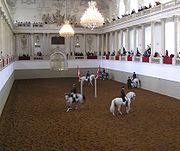
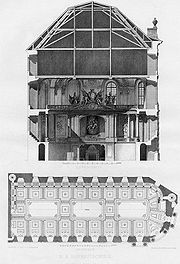
German language
German is a West Germanic language, related to and classified alongside English and Dutch. With an estimated 90 – 98 million native speakers, German is one of the world's major languages and is the most widely-spoken first language in the European Union....
: Spanische Hofreitschule, the "Spanish Court Riding-School") of Vienna
Vienna
Vienna is the capital and largest city of the Republic of Austria and one of the nine states of Austria. Vienna is Austria's primary city, with a population of about 1.723 million , and is by far the largest city in Austria, as well as its cultural, economic, and political centre...
, Austria
Austria
Austria , officially the Republic of Austria , is a landlocked country of roughly 8.4 million people in Central Europe. It is bordered by the Czech Republic and Germany to the north, Slovakia and Hungary to the east, Slovenia and Italy to the south, and Switzerland and Liechtenstein to the...
, is a traditional riding school for Lipizzan
Lipizzan
The Lipizzan or Lipizzaner , is a breed of horse closely associated with the Spanish Riding School of Vienna, Austria, where the finest representatives demonstrate the haute école or "high school" movements of classical dressage, including the highly controlled, stylized jumps and other movements...
horse
Horse
The horse is one of two extant subspecies of Equus ferus, or the wild horse. It is a single-hooved mammal belonging to the taxonomic family Equidae. The horse has evolved over the past 45 to 55 million years from a small multi-toed creature into the large, single-toed animal of today...
s, which perform in the Winter Riding School in the Hofburg. Not only is it a center for classical dressage
Classical dressage
Classical dressage evolved from cavalry movements and training for the battlefield, and has since developed into the competitive dressage seen today...
, the headquarters is a tourist
Tourism
Tourism is travel for recreational, leisure or business purposes. The World Tourism Organization defines tourists as people "traveling to and staying in places outside their usual environment for not more than one consecutive year for leisure, business and other purposes".Tourism has become a...
attraction in Vienna
Vienna
Vienna is the capital and largest city of the Republic of Austria and one of the nine states of Austria. Vienna is Austria's primary city, with a population of about 1.723 million , and is by far the largest city in Austria, as well as its cultural, economic, and political centre...
that offers public performances as well as permitting public viewing of some training sessions. The presentation builds on four centuries of experience and tradition in classical dressage
Classical dressage
Classical dressage evolved from cavalry movements and training for the battlefield, and has since developed into the competitive dressage seen today...
. The leading horses and riders of the school also periodically tour and perform worldwide.
Location
The Spanish Riding School is located between Michaelerplatz and JosefsplatzJosefsplatz
The Josefsplatz is a city-centre public square in the city of Vienna, Austria. The Josefsplatz is centred on a full-sized statue and monument of Joseph II, Holy Roman Emperor mounted on a horse ....
near the Hofburg in central Vienna
Vienna
Vienna is the capital and largest city of the Republic of Austria and one of the nine states of Austria. Vienna is Austria's primary city, with a population of about 1.723 million , and is by far the largest city in Austria, as well as its cultural, economic, and political centre...
. Performances take place in the Winter Riding School, built between 1729–1735. The Winter Riding School is a sunlight- flooded hall, mainly white with some beige and light grey, with a portrait of Emperor Charles VI
Charles VI, Holy Roman Emperor
Charles VI was the penultimate Habsburg sovereign of the Habsburg Empire. He succeeded his elder brother, Joseph I, as Holy Roman Emperor, King of Bohemia , Hungary and Croatia , Archduke of Austria, etc., in 1711...
above the royal box and opposite the entrance (to which the riders always salute before they ride), which measures 55 by 18 meters and is 17 meters in height.
The Spanish Riding School also has summer stables in Heldenberg
Heldenberg
Heldenberg is a small municipality in the district of Hollabrunn in Lower Austria, Austria, about 50 km north-west of Vienna. It is most notable for the Heldenberg Memorial.- Geography :...
-Wetzdorf-Lower Austria. The 68 resident stallions are taken there in July and August for seven weeks, where they are kept in stalls
Stable
A stable is a building in which livestock, especially horses, are kept. It most commonly means a building that is divided into separate stalls for individual animals...
with paddock
Paddock
A Paddock is an enclosure for horses. It may also refer to: People*Algernon Paddock , American politician*Charlie Paddock , American athlete and actor*Del Paddock , American baseball player...
s. The horses are not schooled during this period, but instead are hacked
Trail riding
Trail riding sometimes called horse or pony trekking is riding outdoors on natural trails and roads as opposed to riding in an enclosed area such as a riding arena. The term may encompass those who travel on horses, on mountain bikes, or on motorcycles and other motorized all-terrain vehicles...
in the nearby forest.
History
The riding school was first named during the Austrian EmpireAustrian Empire
The Austrian Empire was a modern era successor empire, which was centered on what is today's Austria and which officially lasted from 1804 to 1867. It was followed by the Empire of Austria-Hungary, whose proclamation was a diplomatic move that elevated Hungary's status within the Austrian Empire...
in 1572, long before the French manege of Antoine de Pluvinel
Antoine de Pluvinel
Antoine de Pluvinel was the first of the French riding masters, and has had great influence on modern dressage. He wrote L’Instruction du Roy en l’exercice de monter à cheval , was tutor to King Louis XIII, and is credited with the invention of using two pillars, as well as using shoulder-in to...
, and is the oldest of its kind in the world. Records show that a wooden riding arena was first commissioned in 1565, but it wasn't until 1729 that Emperor Charles VI commissioned the architect Joseph Emanuel Fischer von Erlach
Joseph Emanuel Fischer von Erlach
Joseph Emanuel Fischer von Erlach, also Fischer von Erlach the younger was an Austrianarchitect of the baroque, Rococo and baroque classicism.-Life and career:...
to build the white riding hall used today. Prior to that time, the School operated from a wooden arena at the Josefsplatz
Josefsplatz
The Josefsplatz is a city-centre public square in the city of Vienna, Austria. The Josefsplatz is centred on a full-sized statue and monument of Joseph II, Holy Roman Emperor mounted on a horse ....
. For a time, the riding hall was used for various ceremonies, but it is now open to the public, who may witness the training and performances by the stallions.
The Spanish Riding School was named for the Spanish
Spain
Spain , officially the Kingdom of Spain languages]] under the European Charter for Regional or Minority Languages. In each of these, Spain's official name is as follows:;;;;;;), is a country and member state of the European Union located in southwestern Europe on the Iberian Peninsula...
horses that formed one of the bases of the Lipizzan
Lipizzan
The Lipizzan or Lipizzaner , is a breed of horse closely associated with the Spanish Riding School of Vienna, Austria, where the finest representatives demonstrate the haute école or "high school" movements of classical dressage, including the highly controlled, stylized jumps and other movements...
breed, which is used exclusively at the school. Today the horses delivered to the Spanish Riding School are bred at the Piber Federal Stud located near the village of Piber
Piber
The Piber Federal Stud is a stud farm dedicated to the breeding of Lipizzan horses, located at the village of Piber, near the town of Köflach in western Styria, Austria...
in western Styria
Styria (state)
Styria is a state or Bundesland, located in the southeast of Austria. In area it is the second largest of the nine Austrian federated states, covering 16,401 km². It borders Slovenia as well as the other Austrian states of Upper Austria, Lower Austria, Salzburg, Burgenland, and Carinthia. ...
, Austria
Austria
Austria , officially the Republic of Austria , is a landlocked country of roughly 8.4 million people in Central Europe. It is bordered by the Czech Republic and Germany to the north, Slovakia and Hungary to the east, Slovenia and Italy to the south, and Switzerland and Liechtenstein to the...
. One of the original studs used to develop the breed was Lipizza, now called Lipica
Lipica
Lipica is a village in the Municipality of Sežana in the Littoral region of Slovenia, close to the border with Italy.Lipica is one of the main tourist centers of the Slovenia's Karst region. It is the origin of the Lipizzaner horses. The Lipica stud farm was established in 1580 by Charles II,...
, near Trieste
Trieste
Trieste is a city and seaport in northeastern Italy. It is situated towards the end of a narrow strip of land lying between the Adriatic Sea and Italy's border with Slovenia, which lies almost immediately south and east of the city...
in modern Slovenia
Slovenia
Slovenia , officially the Republic of Slovenia , is a country in Central and Southeastern Europe touching the Alps and bordering the Mediterranean. Slovenia borders Italy to the west, Croatia to the south and east, Hungary to the northeast, and Austria to the north, and also has a small portion of...
, which gave its name to the breed.
The Spanish Riding School has antecedents in military traditions dating as far back as Xenophon
Xenophon
Xenophon , son of Gryllus, of the deme Erchia of Athens, also known as Xenophon of Athens, was a Greek historian, soldier, mercenary, philosopher and a contemporary and admirer of Socrates...
in Ancient Greece
Ancient Greece
Ancient Greece is a civilization belonging to a period of Greek history that lasted from the Archaic period of the 8th to 6th centuries BC to the end of antiquity. Immediately following this period was the beginning of the Early Middle Ages and the Byzantine era. Included in Ancient Greece is the...
, and particularly from the military horsemanship of the post-medieval ages when knights attempted to retain their battlefield preeminence by shedding heavy armor and learning to manoeuver quickly and with great complexity on a firearms-dominated battlefield.
Traditionally, Lipizzaners at the school have been trained and ridden wholly by men, although the Spanish Riding School states that there has never been an official ban on women. In October 2008, two women, an 18-year-old from the United Kingdom and a 21-year-old from Austria, passed the entrance exam and were accepted to train as riders at the school - the first women to do so in 436 years.
Methods
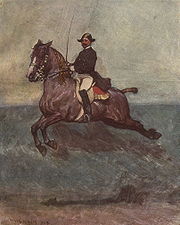
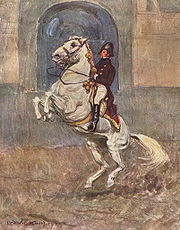
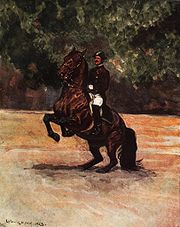
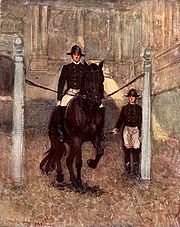
Francois Robichon de la Gueriniere
François Robichon de La Guérinière was a French riding master who had a profound effect on accepted method for correct training of the horse, and is one of the most influential riders on the art of dressage.-History:...
. It is a common myth that the movements were developed to aid in battle; in fact, they were used to strengthen the war horse's body and mind and make him a supreme athlete, not to actually attack. All movements are based on those naturally performed by the horse when at liberty, with the exception of one-tempi changes.
The stallions
Stallion (horse)
A stallion is a male horse that has not been gelded .Stallions will follow the conformation and phenotype of their breed, but within that standard, the presence of hormones such as testosterone may give stallions a thicker, "cresty" neck, as well as a somewhat more muscular physique as compared to...
are taught in three stages:
- Remontenschule: ("forward riding") This stage begins when the horse is first brought to the Spanish Riding School as a 4-year-old. The stallion is taught to be saddled and bridled, and is started on the longeLongeingLongeing or lungeing is a technique for training horses, where a horse is asked to work at the end of a long line and respond to commands from a handler on the ground who holds the line. It is also a critical component of the sport of equestrian vaulting...
to teach him the aidsRiding aidsRiding aids are the cues a rider gives to a horse to communicate what they want the animal to do. Riding aids are broken into the natural aids and the artificial aids.-Natural aids:...
, to improve his obedience, and to strengthen his muscles in preparation for a rider. Work on the longe includes transitions between the walk, trot, and canter, and changes of tempo within the gait, and lasts 2–3 months before a rider is ever placed on the animal's back. After longeing, the horse is ridden in an arena on straight lines, to teach him to respond correctly to the rider's aids while mounted. The main goals during this time are to develop free forward movement in the ordinary (not collected or extended) gaits, with correct contact and on a long rein, and to begin to cultivate straightness. Additionally, the training should have improved the animal's strength and stamina to prepare him for the next stage. - Campagneschule: ("campaign school") The horse is usually ready for the second stage after a year of riding in the first stage, although this time-frame is always adjusted to the individual horse. Young stallions are always placed with experienced riders during this second stage, to help prevent the development of bad habits due to incorrect work. During this time, he is taught collectionCollection (horse)Collection is when a horse carries more weight on his hindlegs than his front legs. The horse draws the body in upon itself so that it becomes like a giant spring whose stored energy can be reclaimed for fighting or running from a predator...
, and is ridden in turns and circles at all gaits. The main purpose of this phase is to develop impulsionImpulsionImpulsion is the pushing power of a horse, which comes from its desire to move powerfully forward with energy. However, speed does not create impulsion, and a rushing horse is more likely to be "flat" than impulsive...
, improve the natural paces, promote self-carriage, make the horse supple and flexible, and gradually develop the muscles of the horse. The horse will learn to bend correctly in the neck, body, and at the pollPoll (horse)The poll is a name of the part of an animal's head, alternatively referencing a point immediately behind or right between the ears. This area of the anatomy is of particular significance for the horse....
as appropriate for his conformation. It is during this time that the majority of training takes place, and the horse learns to shorten and lengthen his gait and perform lateral movementLateral movementLateral movements or lateral flexions within equestrianism, have a specific meaning, used to refer to movements made by a horse where the animal is moving in a direction other than straight forward...
s, with most of the work taking place at the trot. This phase requires the most time of the three, generally two-thirds of the total time it takes to produce the "finished" horse. Before the end of this phase, the stallions are introduced to the double bridleDouble bridleA double bridle, also called a full bridle or Weymouth bridle, is a bridle that has two bits and four reins . One bit is the bradoon , is a modified snaffle bit that is smaller in diameter and has smaller bit rings than a traditional snaffle, and it is adjusted so that it sits above and behind the...
, to refine the rider's aids. - Hohe Schule: ("high school" or Haute Ecole) In this stage, the rider will gradually push the horse to perfection in straightness, contact, suppleness, collection, and impulsion, to produce improved gaits. Through this work, the horse will learn to perform some of the most difficult movements such as pirouettePirouette (dressage)A Pirouette is a French word for the Ballet reference, "to whirl about."A pirouette is a two-track lateral movement asked of a horse in dressage, in which the animal makes a circle with its front end around a smaller circle made by the hind end...
, passagePassage (dressage)The passage is a movement seen in upper-level dressage, in which the horse performs a highly elevated and extremely powerful trot. The horse is very collected and moves with great impulsion....
, piaffePiaffeThe piaffe[p] is a dressage movement where the horse is in a highly collected and cadenced trot, in place or nearly in place. The center of gravity of the horse should be more towards the hind end, with the hindquarters slightly lowered and great bending of the joints in the hind legs...
and One-Tempi-Changes. Many of the exercises first taught in the Campaign school are utilized in this phase, focusing on the quality of the work and using them to help teach the more difficult exercises. The stallions are then assessed to determine if they are suitable for the demanding "airs above the ground," the final step in their training. Once they are chosen, the horses are taught their most-suitable school jump, first on the ground and then under saddle.
The riders, too, are carefully schooled. They first work on the longe
Longeing
Longeing or lungeing is a technique for training horses, where a horse is asked to work at the end of a long line and respond to commands from a handler on the ground who holds the line. It is also a critical component of the sport of equestrian vaulting...
without stirrup
Stirrup
A stirrup is a light frame or ring that holds the foot of a rider, attached to the saddle by a strap, often called a stirrup leather. Stirrups are usually paired and are used to aid in mounting and as a support while using a riding animal...
s and rein
Rein
Reins are items of horse tack, used to direct a horse or other animal used for riding or driving. Reins can be made of leather, nylon, metal, or other materials, and attach to a bridle via either its bit or its noseband.-Use for riding:...
s on well-trained
Horse training
Horse training refers to a variety of practices that teach horses to perform certain behaviors when asked to do so by humans. Horses are trained to be manageable by humans for everyday care as well as for equestrian activities from horse racing to therapeutic horseback riding for people with...
horses for up to 3 years, to teach a balanced and independent seat. They are then allowed to control the animals themselves, under the eye of an experienced rider, until they can perform the high school movmements. With intensive training, this will take 2–4 years. The rider is then allowed to train a young stallion from unbroken up to High School, a process that usually takes 4-6 additional years.
Performances
Performances at the Spanish Riding School were originally only presented to guests of the Court, and then when they were finally opened to the general population at the turn of the century, it was only for special occasions. However, after the fall of the Austro-Hungarian empire in 1918, the school opened up regular performances to the general public to help pay for its upkeep.The original performances were quite short, with the chief riders presenting stallions in the High School movements, airs above the ground, work in-hand and exercises on the long rein, and then a Pas de Deux
Pas de deux (dressage)
A pas de deux is an equestrian performance using two horses. The horses perform dressage movements, usually mirroring each other. It is seen not only in displays and musical freestyles, but also in performances by the Spanish Riding School....
(two horses in mirror image) and a four-rider Quadrille
Quadrille (dressage)
Quadrille is a choreographed dressage ride, commonly performed to music, which is often compared to an equestrian ballet or to a drill team. A minimum of four horses are used, although many times more , which perform movements together. Quadrille may be ridden as a performance, such as those given...
would finish the performance.
The program today has expanded. It begins with the "Young Stallions" which have recently arrived from the stud farm at Piber
Piber
The Piber Federal Stud is a stud farm dedicated to the breeding of Lipizzan horses, located at the village of Piber, near the town of Köflach in western Styria, Austria...
. They demonstrate the first phase of training, in which the horse moves forward and accepts the aids. The next section is the "All Steps and Movements of the High School" where four fully trained stallions perform each of the movements seen in the Olympic Grand Prix Dressage test, including the flying change, passage, pirouette, and piaffe. The horses are ridden in double bridle
Double bridle
A double bridle, also called a full bridle or Weymouth bridle, is a bridle that has two bits and four reins . One bit is the bradoon , is a modified snaffle bit that is smaller in diameter and has smaller bit rings than a traditional snaffle, and it is adjusted so that it sits above and behind the...
, to demonstrate their high level of training. The "Pas De Deux" is then shown, with two horses demonstrating High School movements in mirror image.
The next section is the "Work in Hand", to show how the horses are trained for the school jumps
Airs above the ground
The airs above the ground or school jumps are a series of higher-level classical dressage movements in which the horse leaves the ground. They include the capriole, the courbette, the mezair, the croupade and the levade. None are typically seen in modern competitive dressage...
levade, courbette
Courbette
Courbette may refer to:* One of the Airs above the ground or school jumps performed by horses in classical dressage* Courbette, a commune of the Jura département of France...
, and capriole, all in-hand. This demonstration includes work on the diagonal, on the wall and between the pillars
Column
A column or pillar in architecture and structural engineering is a vertical structural element that transmits, through compression, the weight of the structure above to other structural elements below. For the purpose of wind or earthquake engineering, columns may be designed to resist lateral forces...
. All stallions wear a snaffle
Snaffle
A snaffle bit is the most common type of bit used while riding horses. It consists of a bit mouthpiece with a ring on either side and acts with direct pressure. A bridle utilizing only a snaffle bit is often called a "snaffle bridle," particularly in the English riding disciplines...
bridle, cavesson, side reins
Side reins
Side reins are equipment used when longeing a horse, running from the bit of the bridle to the saddle or surcingle. As a horse training tool, they encourage flexion and softness in the horse's mouth. For longe work with a rider up who does not carry ordinary riding reins, they help calm and...
, some on short hand rein, some with a short back longe
Longe
Longe it was the third album of the Portuguese band Pólo Norte. It was published in 1999 and its producer was Jony Galvão. The great hits were: Vou p´ra Longe e Como uma onda.-Track listing:* 1. Vou p'ra Longe* 2. O Céu Pode Esperar...
. All carry the traditional white saddle of the school. Then one stallion is then worked "On the Long Rein", in which a fully trained Lipizzan performs all the movements it would be asked to do under saddle. In this section, the horse wears a red snaffle bridle and a red shabrack
Shabrack
Shabrack or Shabraque is a saddlecloth, often of goatskin, formerly used by European light cavalry.-Sources and references:*...
(saddlecloth) with the golden coat of arms of the Austrian Empire
Austrian Empire
The Austrian Empire was a modern era successor empire, which was centered on what is today's Austria and which officially lasted from 1804 to 1867. It was followed by the Empire of Austria-Hungary, whose proclamation was a diplomatic move that elevated Hungary's status within the Austrian Empire...
.
The "Airs Above the Ground
Airs above the ground
The airs above the ground or school jumps are a series of higher-level classical dressage movements in which the horse leaves the ground. They include the capriole, the courbette, the mezair, the croupade and the levade. None are typically seen in modern competitive dressage...
" follows; all horses are under saddle, but the riders do not have stirrup
Stirrup
A stirrup is a light frame or ring that holds the foot of a rider, attached to the saddle by a strap, often called a stirrup leather. Stirrups are usually paired and are used to aid in mounting and as a support while using a riding animal...
s. Movements performed include the levade, capriole and courbette
Courbette
Courbette may refer to:* One of the Airs above the ground or school jumps performed by horses in classical dressage* Courbette, a commune of the Jura département of France...
. The performance finishes with the "School Quadrille", consisting of 8 riders working in formation at the walk, trot
Trot
A trot is a type of symmetrical gait in animals.Trot may also refer to:*Trot , the specifics of trotting in horses*Trot , a genre of Korean pop music*Trot , a character from the Oz books of L...
, and canter
Canter
The canter is a controlled, three-beat gait performed by a horse. It is a natural gait possessed by all horses, faster than most horses' trot but slower than the gallop, and is used by all riders. The speed of the canter varies between 16-27 km/h , depending on the length of the stride of the horse...
, with flying changes, pirouettes, the half pass and the passage
Passage (dressage)
The passage is a movement seen in upper-level dressage, in which the horse performs a highly elevated and extremely powerful trot. The horse is very collected and moves with great impulsion....
. The ride is performed to classical music. Lasting 20 minutes, the School Quadrille of the Spanish Riding School is the longest and most difficult in the world.
Dress and equipment
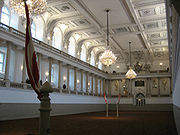
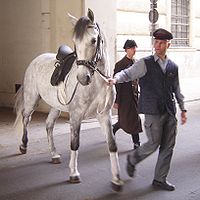
Uniform
A uniform is a set of standard clothing worn by members of an organization while participating in that organization's activity. Modern uniforms are worn by armed forces and paramilitary organizations such as police, emergency services, security guards, in some workplaces and schools and by inmates...
tailcoat, a bicorne
Bicorne
The bicorne or bicorn is an archaic form of hat widely adopted in the 1790s as an item of uniform by European and American military and naval officers...
style hat, white buckskin breeches
Breeches
Breeches are an item of clothing covering the body from the waist down, with separate coverings for each leg, usually stopping just below the knee, though in some cases reaching to the ankles...
, white suede gloves and black top boots. Swan neck spur
Spur
A spur is a metal tool designed to be worn in pairs on the heels of riding boots for the purpose of directing a horse to move forward or laterally while riding. It is usually used to refine the riding aids and to back up the natural aids . The spur is used in every equestrian discipline...
s are also part of the uniform. The empire style uniform (1795–1820 in fashion) has remained relatively unchanged for 200 years.
During performances, the fully trained stallions wear a traditional gold-plated breastplate
Breastplate (tack)
A breastplate is a piece of riding equipment used on horses. Its purpose is to keep the saddle or harness from sliding back....
and crupper
Crupper
A crupper is a piece of tack used on horses and other equids to keep a saddle, harness or other equipment from sliding forward.-Construction:...
, called a Goldzeug. They also carry a "school saddle
Saddle
A saddle is a supportive structure for a rider or other load, fastened to an animal's back by a girth. The most common type is the equestrian saddle designed for a horse, but specialized saddles have been created for camels and other creatures...
", which is made from buckskin
Buckskin
Buckskin may refer to:*Buckskin , leather made of buck hide*Buckskins, an outfit of buckskin leather*Buckskin , a color of horses similar to buckskin leather...
and larger than the more commonly seen English saddle
English saddle
English saddles are used to ride horses in English riding disciplines throughout the world. The discipline is not limited to England or English-speaking countries. This style of saddle is used in all of the Olympic and FEI equestrian disciplines, except for the newly-approved FEI events of...
used by the school when training the stallions and riders. Gold-plated double bridles are only used for performances. All horses, except the young stallions, wear red and gold or green and gold shabrack
Shabrack
Shabrack or Shabraque is a saddlecloth, often of goatskin, formerly used by European light cavalry.-Sources and references:*...
s, or saddlecloths, under the saddle. Red is for "All Steps and Movements of the High School", "Pas de Deux", "On the Long Rein", "The Grand Solo" and "The School quadrille." Green is used for "Work In-Hand" and the "Airs above the Ground". The shabrack is also used to differentiate the status of each rider: the director of the school has three gold bands and gold fringe, the chief riders have three bands and no fringe, riders have two bands, and assistant riders have one.
The young stallions are not exhibited in the same equipment as the more mature animals. They are ridden in a plain snaffle bridle and a simple dressage-style English saddle
English saddle
English saddles are used to ride horses in English riding disciplines throughout the world. The discipline is not limited to England or English-speaking countries. This style of saddle is used in all of the Olympic and FEI equestrian disciplines, except for the newly-approved FEI events of...
. For training sessions, black bridle
Bridle
A bridle is a piece of equipment used to direct a horse. As defined in the Oxford English Dictionary, the "bridle" includes both the headstall that holds a bit that goes in the mouth of a horse, and the reins that are attached to the bit....
s, both snaffle bit bridles and double bridle
Double bridle
A double bridle, also called a full bridle or Weymouth bridle, is a bridle that has two bits and four reins . One bit is the bradoon , is a modified snaffle bit that is smaller in diameter and has smaller bit rings than a traditional snaffle, and it is adjusted so that it sits above and behind the...
s, are used for all horses.
Horses are clean and well groomed. The Capriole horses wear a braided tail wrapped short in a "queue" (known elsewhere as a "mud tail"), which is fixed with a decorative tail bag (Schweiftasche).
Depiction on the euro
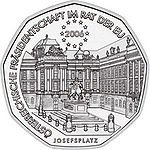
Hofburg Imperial Palace
Hofburg Palace is a palace located in Vienna, Austria, that has housed some of the most powerful people in Austrian history, including the Habsburg dynasty, rulers of the Austro-Hungarian empire. It currently serves as the official residence of the President of Austria...
in the "Josefsplatz
Josefsplatz
The Josefsplatz is a city-centre public square in the city of Vienna, Austria. The Josefsplatz is centred on a full-sized statue and monument of Joseph II, Holy Roman Emperor mounted on a horse ....
" square. The equestrian statue of Joseph II
Joseph II, Holy Roman Emperor
Joseph II was Holy Roman Emperor from 1765 to 1790 and ruler of the Habsburg lands from 1780 to 1790. He was the eldest son of Empress Maria Theresa and her husband, Francis I...
in its center. The wing of the Hofburg can be seen to the right, which contains the Spanish Riding School and the Redoutensäle.
See also
- South African LipizzanersSouth African LipizzanersThe South African Lipizzaners is the name of a riding academy that operates according to the classical model in Kyalami, Midrand , South Africa. In contrast to other classical riding schools, only women ride and train the 40 Lipizzaner stallions. Public performances take place every week on Sundays...
- Cadre NoirCadre NoirThe Cadre Noir is an equestrian display team based in the city of Saumur in western France. The troop was founded in 1828, and gets its name from the black uniforms that are still used today...
- Maximilian WeyrotherMaximilian WeyrotherMax Ritter von Weyrother was Chief Rider of the Spanish Riding School in Vienna from 1813, and Director from 1814 to 1833.His grandfather, Adam Weyrother, a previous Chief Rider at the school, may have known de la Guérinière in Paris. Adam Weyrother traveled to Paris frequently...
- Gottlieb PolakGottlieb PolakGottlieb Polak was Chief Rider and Riding Master of the Spanish Riding School in Vienna during the 1930s, serving until his death in 1942....
- Ernst LindenbauerErnst LindenbauerErnst Lindenbauer was Chief Rider from 1919 - 1950 at the Spanish Riding School in Vienna....
- Alois PodhajskyAlois PodhajskyColonel Alois Podhajsky was the director of the Spanish Riding School in Vienna, Austria as well as an Olympic medal-winner in dressage, riding instructor, and writer.-Career:...
- Georg WahlGeorg WahlGeorg Wahl was Chief Rider at the Spanish Riding School in Vienna and is a dressage instructor, rider and trainer. He is also known as the coach and trainer of Swiss Olympic medalist Christine Stückelberger....
- Piber Federal Stud

